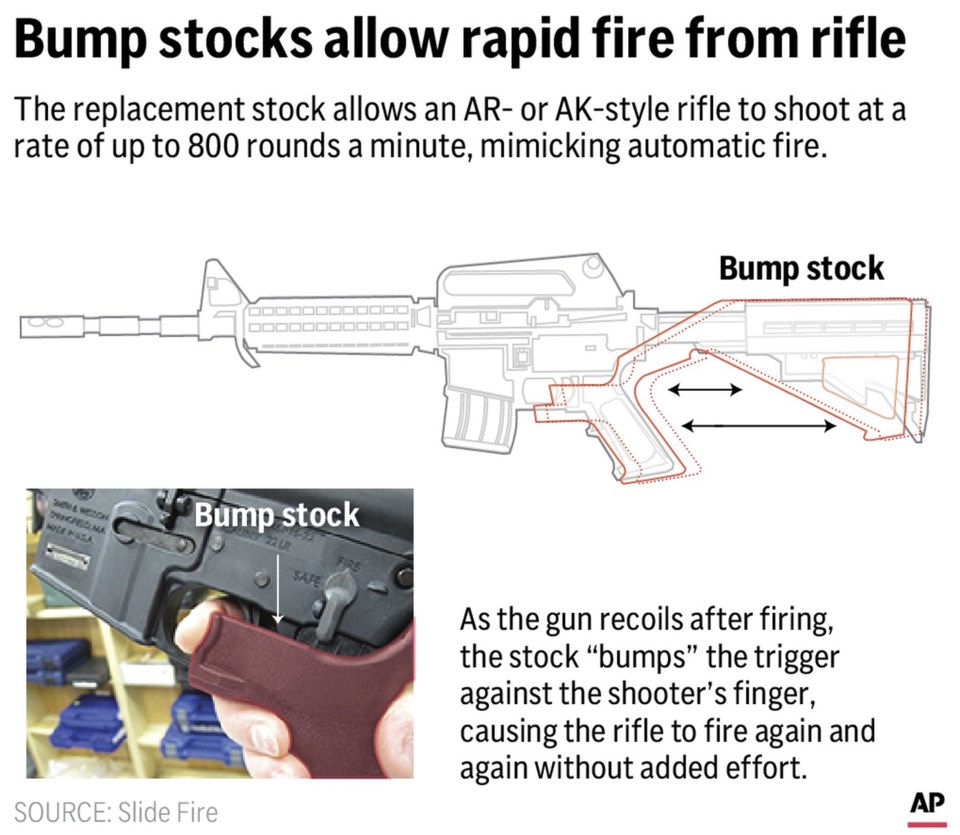WASHINGTON (AP) — The Supreme Court on Friday struck down a Trump-era ban on bump stocks, the rapid-fire gun accessories used in the deadliest mass shooting in modern U.S. history, in a ruling that threw firearms back into the nation's political spotlight.
The high court's conservative majority found that the Trump administration overstepped when it changed course from predecessors and banned bump stocks, which allow a rate of fire comparable to machine guns. The decision came after a gunman in Las Vegas attacked a country music festival with assault rifles equipped with the accessories.
The gunman fired more than 1,000 rounds into the crowd in 11 minutes, sending thousands of people fleeing in terror as hundreds were wounded and dozens were killed in 2017.
The 6-3 majority opinion written by Justice Clarence Thomas found the Justice Department was wrong to declare that bump stocks transformed semiautomatic rifles into illegal machine guns because, he said, they don’t “alter the basic mechanics of firing.”
Justice Samuel Alito agreed but wrote a short separate opinion to stress that Congress can change the law. Justice Sonia Sotomayor said in a dissent joined by the court’s liberals and read out loud in the courtroom that she hoped Congress would act.
The ruling wasn't directly about the Second Amendment, but nevertheless threw guns back into the center of a role-reversal political conversation that had Democrats criticizing the ruling that upended the actions of a GOP administration.
President Joe Biden called on Congress to act and Democratic Sen. Catherine Cortez Masto of Nevada referenced the massacre in her state as she encouraged Congress to permanently prohibit “these devastating devices.” Still, prospects for gun control legislation in the current divided Congress are dim.
Imposing a ban through regulation rather than legislation during Donald Trump’s presidency took pressure off Republicans to act following the massacre and another mass shooting in Parkland, Florida.
As Trump courts gun owners while running to retake the presidency, he has appeared to play down his own administration’s actions on bump stocks, telling National Rifle Association members in February that “nothing happened” on guns during his presidency despite “great pressure.”
He told the group that that if he is elected again, “no one will lay a finger on your firearms.”
After the court's decision was announced on Friday, his campaign team expressed respect for the ruling before quickly pivoting to his endorsement by the NRA.
The Biden campaign decried the ruling and backed new restrictions on assault weapons and high-capacity magazines.
It was the latest gun case for the Supreme Court, whose conservative supermajority previously handed down a landmark decision expanding gun rights in 2022 and is weighing another gun case challenging a federal law intended to keep guns away from people under domestic violence restraining orders.
The arguments in the bump stock case, though, were more about whether the ATF had overstepped its authority, not the Second Amendment covering firearms.
Justices from the court’s liberal wing suggested it was “common sense” that anything capable of unleashing a “torrent of bullets” was a machine gun under federal law. Conservative justices, though, raised questions about the effects of the ATF changing its mind a decade after declaring the accessories legal.
The high court took up the case after a split among lower courts over bump stocks, which were invented in the early 2000s. Under Republican President George W. Bush and Democrat Barack Obama, the ATF decided that bump stocks didn’t transform semiautomatic weapons into machine guns. The agency reversed those decisions at Trump’s urging. That was after the shooting in Las Vegas and another mass shooting at a Parkland, Florida, high school that left 17 dead.
Bump stocks are accessories that replace a rifle’s stock, the part that rests against the shoulder. They harness the gun’s recoil energy so that the trigger bumps against the shooter’s stationary finger, allowing the gun to fire at a similar speed as an automatic weapon. Fifteen states and the District of Columbia have their own bans on bump stocks, though some could be affected by the high court's ruling.
The plaintiff, Texas gun shop owner and military veteran Michael Cargill, was represented by the New Civil Liberties Alliance, a group funded by conservative donors like the Koch network. His attorneys acknowledged that bump stocks allow for rapid fire but argued that they are different because the shooter has to put in more effort to keep the gun firing.
Cargill celebrated the ruling in a video posted online, saying the case would have ripple effects by hampering other federal gun restrictions by the bureau of Alcohol, Tobacco, Firearms and Explosives. “I’m glad I stood up and fought,” he said.
The Biden administration had argued the ATF changed its mind on bump stocks after doing a more in-depth examination spurred by the Las Vegas shooting and came to the right conclusion.
There were about 520,000 bump stocks in circulation when the ban went into effect in 2019, requiring people to either surrender or destroy them, at a combined estimated loss of $100 million, the plaintiffs said in court documents.
___
Associated Press writers Mark Sherman and Farnoush Amiri in Washington, Jill Colvin in New York and Jim Vertuno in Austin, Texas, contributed to this report.
___
Follow the AP’s coverage of the U.S. Supreme Court at https://apnews.com/hub/us-supreme-court.
Lindsay Whitehurst, The Associated Press

